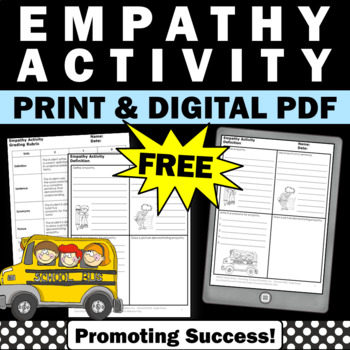Empathy Activities and Games for Kids
--------------------------------------------
NOTE: Click HERE to find the following activities in a no prep printable packet.
------------------
Activity 1: Defining Empathy
Instruct the students to draw four squares on their paper.
Square 1: Define the word.
Square 2: Use it in a sentence.
Square 3: Write synonyms for the word.
Square 4: Draw a picture to demonstrate the word.
Activity 2: Perspective Taking
Instruct students to role-play some scenarios that require perspective taking.
Group 1: Role play a student missing a basket in the final seconds of the game.
Group 2: Role play a student not included in a recess game.
Group 3: Role play a student who was the only one who didn't pass the test.
Group 4: Role play a student who was preparing a speech to give in front of the whole school.
Group 5: Role play a student who fell and was injured at recess.
Activity 3: Points of View
Read "The True Story of the 3 Little Pigs" and the original version as well.
Divide the students into two groups. One group must take the point of the view of the wolf. The other group takes the point of view of the pigs. Students may have a debate modeling how to respect others' points of view or they may write a letter to the other group.
Activity 4: Listening to Others
Students may sit in a circle. Begin the game by having the first person whisper a sentence in the next person's ear. Players continue to repeat the sentence by whispering it in the next players ear. The game continues until the last player hears the sentence. The last play says the sentence out loud so everyone may see if the sentence changed.
Instruct students to brainstorm individually or in groups at lease ten ways to improve listening skills.
Activity 5: Being Different is Beautiful
Instruct students to create classroom posters by completing the sentence, "Being different is _________." Encourage the students to draw colorful pictures to go along with their sentences.
---------------------------------------
Empathy Activities for Students
Empathy Activities for Students
---------------------------------------
You may also like the following teaching resources from our Amazon Associate store:
-------------------------------------
Shelly Anton is a participant in the Amazon Services LLC Associates Program, an affiliate advertising program designed to provide a means for sites to earn advertising fees by advertising and linking to Amazon.com. ** This means there are Amazon affiliate links in these blog posts. This does not mean you pay a dime more when you purchase a product through the link. It just means I am trying to save you valuable teacher time by making it easier for you to find valuable resources for your students, and I earn a few cents for my research and time. Thank you for all you do for kids!





















